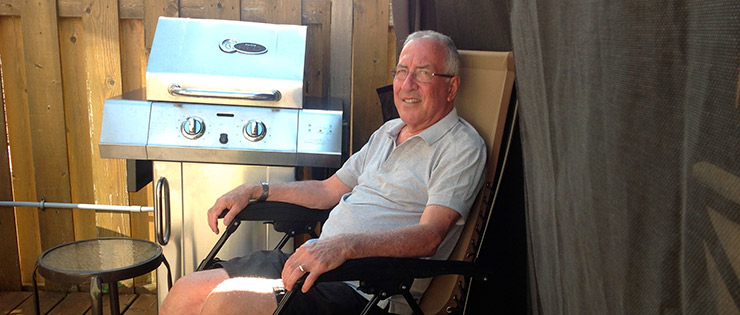Battle of the blood thinners hits home for Ottawa man

Unexplained blood clots in his lungs put retired nursing orderly Robert Jean Tessier on blood thinning medications for life. His specialist, Dr. Lana Castellucci, is doing research to find out whether the newer drugs are as safe or effective as the one that has been used for 50 years.
While climbing the stairs in his Ottawa home one spring evening, Robert Jean Tessier’s back pain turned into something far worse.
“I hit a wall and I couldn’t breathe,” said the 69-year-old retired nursing orderly. “I know my body, and I knew something wasn’t right.”
A CT scan revealed several blood clots in his lungs. The danger only sank in once a doctor asked Tessier whether he wanted to be resuscitated if he stopped breathing.
“I was in denial,” said Tessier. “Because I had worked at the hospital and kept on top of everything, I didn’t think it was that bad.”
Thankfully, doctors were able to get rid of the clots with injections of a blood thinner. But because they didn’t know what had caused the clots, Tessier has to take blood-thinning medication for the rest of his life to prevent new ones from forming.
At first, Tessier took a new drug called rivaroxaban, but after six months his Ontario Health Insurance Plan would no longer cover the $150-a-month medication. Dr. Lana Castellucci, a blood-clot physician at The Ottawa Hospital, recommended that he switch to warfarin, a blood thinner that has been around for 50 years and costs pennies a day. The downside is that Tessier now has to go in for blood work regularly to make sure he’s getting the right dose, and be careful with his diet and interactions with other medications – things he didn’t need to do on rivaroxaban.
Dr. Castellucci is the Canadian lead of an international clinical trial that will definitively determine whether newer blood thinners like rivaroxaban and apixaban are as safe or as effective as warfarin for long-term use.
“The use of these newer drugs is increasing, but cost is a barrier for some people,” said Dr. Castellucci, also an assistant professor at the University of Ottawa. “We hope our results will uncover which blood thinner is the safest, which might be able to change some drug coverage policies.”
Today, warfarin is working well for Tessier. He keeps busy doing yard work and building model boats. “It took me about a year to feel like I was okay,” said Tessier. “My life has changed – I’m more cautious now. If anything develops that is out of the ordinary, I get it checked out.”
The Ottawa Hospital: Inspired by research. Driven by compassion
The Ottawa Hospital is one of Canada’s largest learning and research hospitals with over 1,100 beds, approximately 12,000 staff and an annual budget of over $1.2 billion. Our focus on research and learning helps us develop new and innovative ways to treat patients and improve care. As a multi-campus hospital, affiliated with the University of Ottawa, we deliver specialized care to the Eastern Ontario region, but our techniques and research discoveries are adopted around the world. We engage the community at all levels to support our vision for better patient care. See www.ohri.ca for more information about research at The Ottawa Hospital.
University of Ottawa
The University of Ottawa is home to over 50,000 students, faculty and staff, who live, work and study in both French and English. Our campus is a crossroads of cultures and ideas, where bold minds come together to inspire game-changing ideas. We are one of Canada’s top 10 research universities—our professors and researchers explore new approaches to today’s challenges. One of a handful of Canadian universities ranked among the top 200 in the world, we attract exceptional thinkers and welcome diverse perspectives from across the globe. www.uottawa.ca
For further information, please contact
Amelia Buchanan
Senior Communication Specialist
Ottawa Hospital Research Institute
Office: 613-798-5555 x 73687
Cell: 613-297-8315
ambuchanan@ohri.ca
The Ottawa Hospital is a leading academic health, research and learning hospital proudly affiliated with the University of Ottawa and supported by The Ottawa Hospital Foundation.


